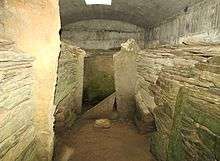Tomb of the Eagles

The Tomb of the Eagles, or Isbister Chambered Cairn, is a Neolithic chambered tomb located on a cliff edge at Isbister on South Ronaldsay in Orkney, Scotland. First explored by Ronald Simison, a farmer, when digging flagstones in 1958, he conducted his own excavations at the site in 1976. Alerted by Simison, archaeologist John Hedges then mounted a full study, prepared a technical report and wrote a popular book[1] that cemented the tomb's name.[2]
16,000 human bones were found at the site, as well as 725 from birds. These were identified as predominantly belonging to the white-tailed sea eagle (Haliaeetus albicilla) and represented between 8 and 20 individuals. These were originally interpreted as a foundation deposit; however, this interpretation has been challenged by new dating techniques. These reveal that the eagles died c. 2450–2050 BCE, up to 1,000 years after the building of the tomb. This confirms growing evidence from other sites that the neolithic tombs of Orkney remained in use for many generations.[2]
See also
References
- ↑ Hedges, J. 1990. Tomb of the Eagles: Death and Life in a Stone Age Tribe. New Amsterdam Books. ISBN 0-941533-05-0
- 1 2 Pitts, M. 2006. Flight of the eagles. British Archaeology 86: 6
External links
| Wikimedia Commons has media related to Isbister Chambered Cairn. |
Coordinates: 58°44′24″N 2°55′19″W / 58.740°N 2.922°W